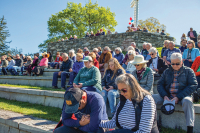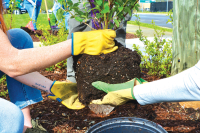The butternut in the creek bend
Like dimly-lit rhododendron tunnels or ancient sphagnum-layered bogs, creek bends are special places that invariably precipitate beauty.
Sitting in the blue-gray shadows of my porch, I watch lower Lands Creek flow by on its way to the Gulf of Mexico. Down past the old outhouse, the creek bends southeastwardly and with mindless precision slices like a blade into a bluff of hornblende gneiss. Random glints of low-slanted evening light trace the graceful arc of the bend.
Horneblende is an aluminum silicate of iron and magnesium that may contain potassium. On slopes and in creek bends where flora is especially varied and lush, horneblende gneiss is often the key ingredient.
The bluff Lands Creek has been sculpting for thousands of years is shaded by a dense canopy composed of basswood, slippery elm, various white and red oak species, butternut, beech, striped and red maple, silverbell, serviceberry, black cherry, dogwood, ironwood, and various species of hickory. The under story is composed of rosebay rhododendron, mountain laurel, and dog-hobble. There are grape vines and tangles of greenbrier. Ferns that come to mind are cinnamon, Christmas, New York, glade, lady, hay-scented, ebony spleenwort, winged beech, and maidenhair. There are mosses, liverworts, sedges, ground pine, and grasses. The spring wildflowers are prolific.
In other words, the factors that created a bend in a creek exposed various levels of a mountainside containing horneblende gneiss and, in the process, also created a small natural garden of great beauty, without any “help” whatsoever from any person.
My favorite tree in the bend is a good-sized butternut ... the perfect tree for this setting. The butternut walnut (Juglans cinerea), which some people call white walnut, is surrounded by several of its close cousins, the ever-present black walnuts (J. nigra). But you can distinguish the smaller butternut walnut in a heartbeat.
Related Items
Butternut has a large terminal leaflet, whereas black walnut has either a small terminal leaflet or no terminal leaflet at all. The bark of mature butternut walnut trees is gray-white and divided into deep furrows that form a characteristic rough diamond-shaped pattern. Its leaves and fruit drop early revealing conspicuous, 3-lobed (inversely triangular) leaf scars on twigs, each of which is surrounded by a raised, downy, gray pad or “eyebrow.” These scars make the leaf scars look for all the world like a ram’s face.
Unlike black walnut — which bears dark-green rounded fruits that turn dark black-brown — butternut walnut displays oblong fleshy light-green fruits that turn a light-brown buttery color with maturity.
Cherokees traditionally used the inner bark as a carthartic and harvested the nuts as food. To this day, they make a black dye to color basket splints from butternut roots and carve the soft wood for masks and other items. Mountaineers used the inner bark and fruit husks to obtain a yellow or orange agent to dye homespuns; hence, during the Civil War backwoods Confederate troops dressed in homespun “uniforms” of butternut-dyed cloth became known as “Butternuts.” In country churches here in the mountains, an altar carved of a satiny light-brown wood and displaying bands of paler sapwood might well be made of butternut.
Unfortunately, butternut walnut — like so many tree species — is being infested by a killing agent. In the butternut’s instance, the agent is a fungus first identified during the late 1960s in eastern North America. This canker has now spread throughout the entire range of the tree from Minnesota south to Arkansas and from New England south into Georgia.
In Charles E. Little’s The Dying of the Trees: The Pandemic in America’s Forests (Viking, 1995), the lens-shaped cankers that are formed when a tiny fungus spore enters the tree through an injured limb or trunk are described as “necrotic lesions of the bark and cambium layer” that “spread throughout the tree, even to the nut husks, eventually girdling the main limbs and trunk and causing the tree to die. The death is slow, taking several years, but certain.”
For the time being, however, the evening light that glints off the arc of water below our place is still refracted by the patterns in the bark of the butternut tree … diamonds in a near-perfect creek bend.
George Ellison wrote the biographical introductions for the reissues of two Appalachian classics: Horace Kephart’s Our Southern Highlanders and James Mooney’s History, Myths, and Sacred Formulas of the Cherokees. In June 2005, a selection of his Back Then columns was published by The History Press in Charleston as Mountain Passages: Natural and Cultural History of Western North Carolina and the Great Smoky Mountains. Readers can contact him at P.O. Box 1262, Bryson City, N.C., 28713, or at This email address is being protected from spambots. You need JavaScript enabled to view it..









